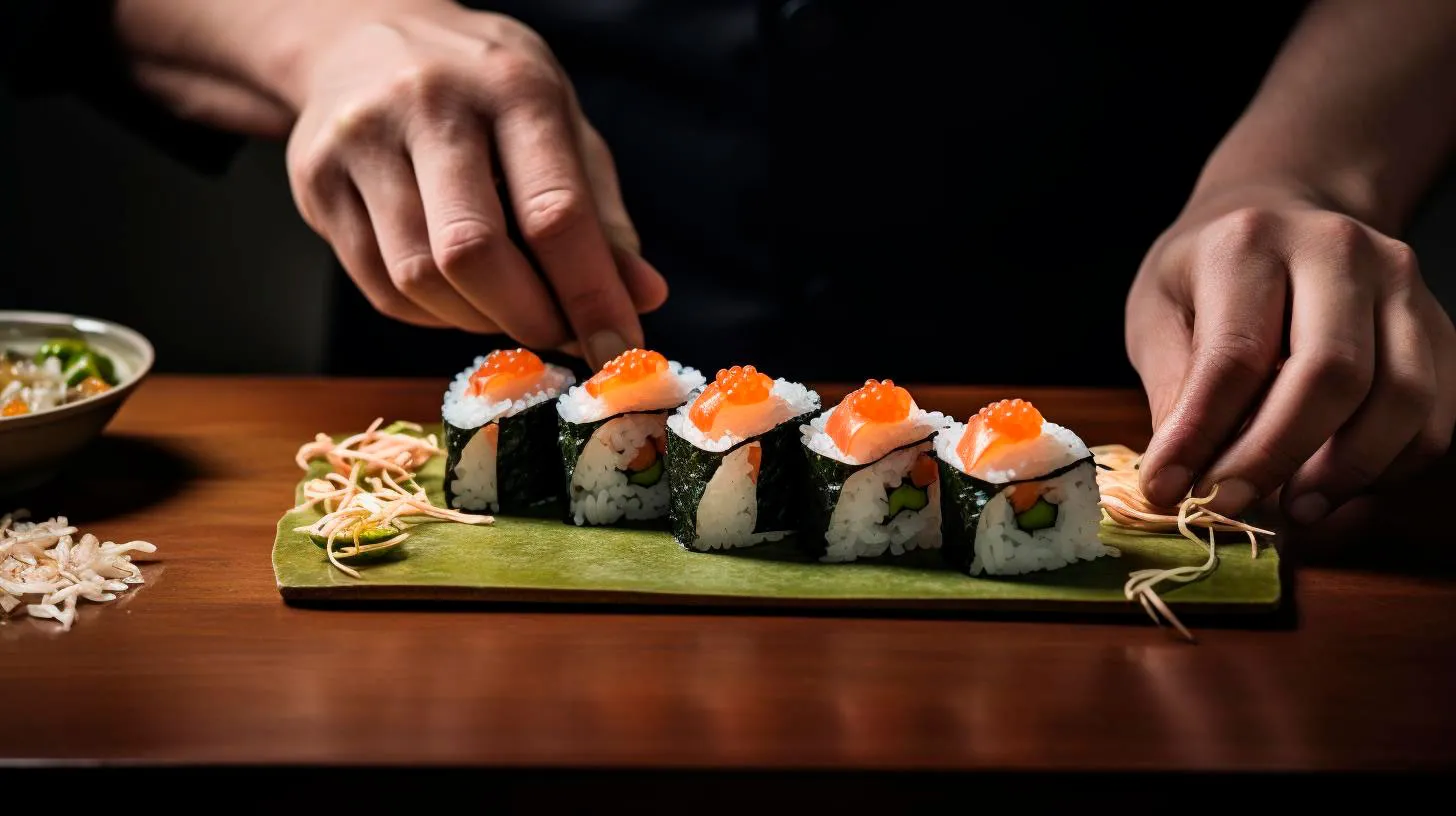Discover the Secrets of Crafting Delicious Sushi
Why Make Your Own Sushi?
Before we dive into the secrets of crafting delicious sushi, let’s take a moment to highlight why making your own sushi is both rewarding and satisfying:
- Unlimited creativity: When you make sushi at home, the possibilities are endless. You can experiment with various ingredients, flavors, and textures to create unique sushi rolls that suit your taste.
- Freshness guaranteed: By controlling the quality of ingredients, you can ensure the freshness and cleanliness of every sushi bite. This is particularly important when it comes to raw fish, as the freshness greatly impacts the overall taste.
- Cost-effective: Dining out at a sushi restaurant can be quite expensive. However, by making your own sushi, you can save money while still enjoying this delectable delicacy.
Secrets to Crafting Delicious Sushi
1. Choose the Freshest Ingredients
As with any dish, the secret to creating delicious sushi starts with sourcing the freshest and highest quality ingredients. Here are some tips to keep in mind:
- Opt for sushi-grade fish, which is specially labeled for raw consumption and ensures both safety and flavor.
- Use short-grain sushi rice, known for its stickiness and ability to hold the shape of your rolls perfectly.
- Add a variety of fresh and colorful vegetables, such as cucumber, avocado, and carrots, to enhance the taste and presentation of your sushi rolls.
2. Master the Art of Rolling
Rolling sushi can be a bit challenging at first, but with practice, you’ll become a sushi-rolling pro in no time. Follow these steps for a seamless rolling experience:
- Place a sheet of nori (seaweed) on a bamboo sushi mat.
- Spread a thin layer of sushi rice evenly over the nori, leaving a small border at the top.
- Add your choice of fillings (fish, vegetables, or both) horizontally near the bottom edge of the nori.
- Using the bamboo mat, start rolling the sushi from the bottom, applying gentle pressure to ensure a tight and compact roll.
- Once the roll is complete, use a sharp knife to slice it into bite-sized pieces.
- Repeat these steps for each sushi roll variation you create.
3. Don’t Forget the Dipping Sauces
No sushi experience is complete without the perfect dipping sauce. While soy sauce is a classic choice, consider enhancing your sushi flavors with these popular dipping sauces:
- Wasabi Mayo: Combine wasabi paste with mayonnaise for a creamy and slightly spicy dipping sauce.
- Ponzu Sauce: Create a tangy and citrusy sauce by mixing soy sauce, citrus juice, and a touch of vinegar.
- Eel Sauce: Make a sweet and savory sauce using soy sauce, sugar, and mirin (sweet rice wine).
Key Takeaways
Sushi-making may seem like an intricate art, but with the right techniques and a sense of creativity, you can create delicious sushi rolls that rival those served in top-notch restaurants. Remember these key takeaways as you embark on your sushi-making journey:
- Select the freshest ingredients to ensure the best taste and quality of your sushi.
- Master the art of rolling by practicing the technique until you achieve perfectly-shaped sushi rolls.
- Experiment with various dipping sauces to elevate the flavors and create a unique dining experience.
So, why not grab your bamboo mat, prepare your favorite fillings, and start rolling your way to sushi perfection today? You’ll soon discover that crafting delicious sushi is not only a culinary adventure but a rewarding and satisfying experience.
Learn the Art of Sushi Making
In this guide, we’ll walk you through the basics of sushi making and provide you with some helpful tips along the way. Let’s dive in!
The Basics of Sushi
Sushi originated in Japan and is traditionally made with vinegared rice and various toppings or fillings. It’s important to note that sushi does not always mean raw fish; it can also include cooked fish, vegetables, or even fruits. The most common types of sushi include:
- Nigiri: Hand-pressed sushi consisting of a small mound of rice topped with seafood or other ingredients.
- Maki: Sushi rolls made by wrapping a layer of rice and ingredients in a sheet of seaweed (nori).
- Sashimi: Thinly sliced raw fish or seafood, served without rice.
Getting Started with Sushi Making
Before you become a sushi master, you’ll need to gather a few essential tools and ingredients. Here’s what you’ll need:
- Sushi rice: Short-grain rice specifically used for sushi. It has a sticky texture when cooked.
- Nori: Sheets of dried seaweed that serve as the outer layer for sushi rolls.
- Sushi-grade fish or other toppings: Choose fresh fish, vegetables, or other ingredients of the highest quality.
- Bamboo mat: A sushi rolling mat that helps shape and roll sushi evenly.
- Soy sauce, wasabi, and pickled ginger: Traditional accompaniments for sushi.
Now that you have your tools and ingredients ready, it’s time to start making sushi!
Step-by-Step Guide to Making Sushi
1. Prepare the Sushi Rice
First, wash the sushi rice in cold water until the water runs clear. Cook the rice according to the package instructions or using a rice cooker. Once cooked, let the rice cool slightly before seasoning it with sushi vinegar (a mixture of rice vinegar, sugar, and salt).
2. Slice the Ingredients
If using fish or other toppings, make sure they are fresh and sliced thinly. Vegetables should also be sliced into long, thin strips for easy rolling.
3. Set up Your Rolling Station
Place a bamboo mat on a clean surface and cover it with a sheet of plastic wrap. This will prevent the rice from sticking to the mat.
4. Roll the Sushi
Place a sheet of nori on the bamboo mat and cover it with a thin layer of sushi rice, leaving a small border uncovered. Add your choice of fillings along the center of the nori. Use the bamboo mat to tightly roll the sushi, applying gentle pressure as you go. Wetting the uncovered border of nori with water will help seal the roll.
5. Slice and Serve
Once the roll is complete, use a sharp knife to slice it into bite-sized pieces. Serve the sushi with soy sauce, wasabi, and pickled ginger for dipping.
Benefits of Making Sushi at Home
Making sushi at home has several advantages:
- You have control over the quality of ingredients used.
- It can be a fun and creative activity for you and your family or friends.
- It can be a cost-effective alternative to dining out at sushi restaurants.
- You can customize the sushi to suit your personal taste preferences.
Key Takeaways
Learning the art of sushi making opens up a world of culinary creativity. By following these steps, you’ll be well on your way to making delicious sushi at home:
- Gather the essential tools and ingredients.
- Prepare the sushi rice and slice the ingredients.
- Set up your rolling station using a bamboo mat and plastic wrap.
- Roll the sushi tightly, using gentle pressure.
- Slice the roll into bite-sized pieces and serve with accompaniments.
So why not try your hand at sushi making? With a little practice and experimentation, you’ll be impressing your friends and family with your homemade sushi creations in no time!
Learn the Art of Sushi Making
In this article, we will dive deep into the world of sushi making, sharing tips, techniques, and essential knowledge to help you create delicious rolls right in your own kitchen.
The Basics of Sushi Making
Before we start rolling, let’s familiarize ourselves with the basic components of sushi:
- Sushi Rice: The foundation of any sushi roll is the sushi rice. This short-grain rice is cooked with vinegar, sugar, and salt, imparting a distinct flavor.
- Nori: Thin sheets of seaweed that encase the sushi roll.
- Sashimi: Thin slices of raw fish or seafood.
- Vegetables and Fillings: From avocado and cucumber to tempura and crab sticks, the fillings can vary according to your preferences.
The Art of Sushi Rolling
Now that we have our ingredients ready, let’s dive into the art of sushi rolling. Follow these steps to create your sushi masterpiece:
- Prepare Your Workstation: Set up a clean and organized workspace with a bamboo sushi rolling mat, a sharp knife, a bowl of water to dip your fingers in, and a clean kitchen towel.
- Place the Nori: Lay a sheet of nori on the sushi mat, ensuring that the rough side faces up.
- Spread the Rice: Wet your hands to prevent sticking and evenly spread a thin layer of sushi rice onto the nori, leaving a small border at the top uncovered.
- Add Fillings: Arrange your chosen ingredients in a line in the center of the rice. Be creative and experiment with different combinations.
- Roll it Up: Starting from the edge closest to you, use the bamboo mat to roll the sushi into a tight cylinder. Apply gentle pressure to ensure a firm and compact roll.
Once you’ve mastered the basic sushi roll, you can explore a wide variety of sushi styles, including maki (rolls), nigiri (hand-pressed sushi), and temaki (hand rolls). Remember, practice makes perfect, so don’t be discouraged if your first attempts aren’t flawless. It’s all part of the learning process!
The Advantages of Making Sushi at Home
Making sushi at home offers numerous advantages that go beyond satisfying your cravings. Here are some key takeaways:
- Healthier Option: By making sushi at home, you have control over the ingredients, ensuring freshness and quality. You can opt for healthier options like brown rice or incorporate more vegetables for a balanced meal.
- Saves Money: Dining out at a sushi restaurant can be expensive. By making sushi at home, you can enjoy the same delicious rolls at a fraction of the cost.
- Creative Freedom: When you make sushi at home, you can experiment with different fillings, sauces, and presentations. Unleash your creativity and invent your own signature rolls.
- Entertainment and Bonding: Sushi making can be a fun activity to do with friends or family. Turn it into a sushi-making party where everyone can customize their rolls and enjoy the process together.
Key Takeaways
Learning the art of sushi making opens up a world of culinary possibilities. Here are the key takeaways to remember:
- Sushi making involves basic components such as sushi rice, nori, and fillings.
- Master the art of sushi rolling by following the steps and practicing regularly.
- Benefits of making sushi at home include healthier options, cost savings, creative freedom, and an opportunity for entertainment and bonding.
So, why not embark on a sushi-making adventure and impress your guests with your newfound skills? From traditional rolls to innovative creations, the art of sushi making is a journey that rewards both the palate and the soul.
Attend a Sushi Making Workshop
Why Attend a Sushi Making Workshop?
There are several compelling reasons why you should consider attending a sushi making workshop:
- Hands-on Experience: Unlike simply watching a cooking show or reading a recipe, attending a sushi making workshop gives you the opportunity to roll up your sleeves and participate in the sushi-making process firsthand.
- Learn from Professionals: Sushi making workshops are conducted by experienced chefs who have mastered the art of sushi making. They will teach you everything from selecting the freshest ingredients to different sushi techniques and knife skills.
- Discover the Secrets: Ever wondered how to perfectly season sushi rice or create intricate sushi rolls? By attending a workshop, you’ll gain insights into the secrets of sushi making that are not commonly found in cookbooks or online tutorials.
- Cultural Experience: Sushi making is deeply rooted in Japanese culture. Attending a workshop not only enhances your culinary skills but also exposes you to the rich cultural heritage behind this iconic cuisine.
- Unleash Your Creativity: Sushi making allows for endless possibilities when it comes to ingredients, fillings, and presentations. At a workshop, you can let your creativity shine as you experiment with different flavors and innovative sushi designs.
- Become a Sushi Aficionado: By attending a sushi making workshop, you’ll gain valuable knowledge and skills that will make you a true sushi aficionado. Impress your friends and family with your sushi-making prowess at your next dinner party!
The Growing Popularity of Sushi Making Workshops
The popularity of sushi making workshops has soared in recent years, and it’s easy to understand why. Here are some statistics that shed light on this growing trend:
- In the United States, the market size of sushi restaurants is estimated to be worth $3.96 billion in 2021, with a projected annual growth rate of 2.2%.
- The global sushi market is expected to reach a value of $30 billion by 2026.
- According to a survey conducted by the American Culinary Federation, sushi is consistently ranked as one of the top culinary trends across the United States.
Key Takeaways
Attending a sushi making workshop offers numerous advantages and key takeaways:
- Hands-on learning: Experience the joy and satisfaction of creating sushi yourself.
- Expert guidance: Learn from professional sushi chefs who are passionate about their craft.
- Unlock culinary secrets: Discover the tricks and techniques behind perfect sushi making.
- Embrace cultural heritage: Immerse yourself in the rich traditions and history of sushi.
- Express your creativity: Explore unique flavor combinations and create stunning sushi presentations.
- Impress others: Become the go-to sushi expert among your friends and family.
- Keep up with culinary trends: Stay ahead of the curve in the ever-evolving world of food.
So, if you’re ready to embark on a sushi adventure, don’t miss the opportunity to attend a sushi making workshop. It’s an experience that will not only satisfy your taste buds but also expand your culinary horizons. Discover the art of sushi making and unleash your inner sushi chef!



